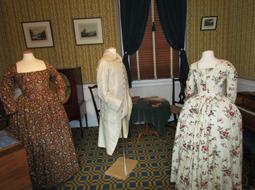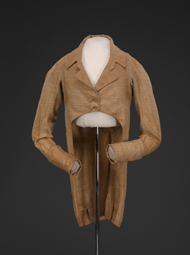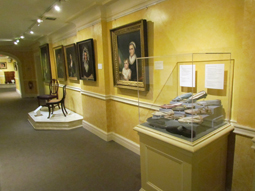"An Agreeable Tyrant: Fashion After the Revolution"

If you visit DAR Headquarters between now and the end of April, you will see something new and different in some of the DAR Museum period rooms: mannequins!
This year’s exhibit is installed in twelve period rooms on all four floors, instead of in the Museum Gallery, which will soon be under renovation. “An Agreeable Tyrant: Fashion after the Revolution” displays over fifty mannequins depicting men’s and women’s clothing in the first fifty years of our nation. The outfits are shown in rooms which correspond (more or less) to the period of the clothing depicted.
The title quote comes from a satirical newspaper article first appearing in American papers in the 1760s and often repeated after the Revolution. “What is Fashion?” the “English Catechism” demanded. “An agreeable tyrant,” was the answer. Fashion’s whims were characterized as a form of tyranny, and we had just fought a war to end tyranny. We wanted cultural, as well as political independence from Britain. Why should we follow the fashions set by a corrupt aristocracy in Europe? Writers (all men, of course) insisted American women should stay at home spinning and weaving and not spend their money on fripperies like calico fabric (like that used in the dresses in the West Virginia room), silk ribbons, lace, and so on. (No word from the ladies on how they took this.)
 “Homespun” fabrics did exist, and were sometimes adopted as a political gesture. A “homespun” coat in the DAR Museum collection, probably worn by John Gilbert of Georgia in about 1805-10, was likely a statement of support for the embargo and non-importation acts of the early 1800s. Its fashionable cut is at odds with its deliberately coarse fabric.
“Homespun” fabrics did exist, and were sometimes adopted as a political gesture. A “homespun” coat in the DAR Museum collection, probably worn by John Gilbert of Georgia in about 1805-10, was likely a statement of support for the embargo and non-importation acts of the early 1800s. Its fashionable cut is at odds with its deliberately coarse fabric.
Mostly, however, Americans continued to copy English and French styles and to wear imported fabrics. But they modified cutting-edge European styles to their own taste. The exhibit explores how Americans navigated the tricky waters of aspiring to be fashionable while maintaining their integrity and adapting to their local standards. It is organized mostly chronologically.
Most of the rooms include a combination of fully dressed and accessorized mannequins showing the full look of the period, and some simpler torso forms just showing a dress or coat. This approach allows us to show the whole outfit in some cases, while focusing on an individual garment in others.
Two rooms are set up as “scenarios,” with all realistic mannequins fully dressed and suggesting a scene. In the New York room, the magnificent new gilt wallpaper is a perfect backdrop for the elegance of an evening party of about 1810.
 Downstairs on the lower level, three thematic rooms (outerwear in the Georgia tavern; working wear in the Oklahoma kitchen; and more cutting-edge European fashion in the North Carolina room) conclude the exhibit. But we have also added cases in the Yochim Gallery filled with accessories, and portraits and furniture of the same era as the clothing.
Downstairs on the lower level, three thematic rooms (outerwear in the Georgia tavern; working wear in the Oklahoma kitchen; and more cutting-edge European fashion in the North Carolina room) conclude the exhibit. But we have also added cases in the Yochim Gallery filled with accessories, and portraits and furniture of the same era as the clothing.
The exhibit has been tremendously popular. In mid-October, The Jane Austen Society of North America visited us during their convention in Washington. They especially loved the New York room, which we renamed Pemberley after Mr. Darcy’s home in Pride and Prejudice, and dubbed the mannequins Miss Bingley, Eliza Bennet, Miss Darcy, and Mr. Darcy!
Washington, DC has many costumers and reenactors, and some have visited the DAR Museum in costume for this exhibit. Additionally, two volunteers who worked extensively on the exhibit recreated specific ensembles from the late 1790s and wore them on a visit.
We hope that many of you will be able to see the exhibit—perhaps while additional rooms are decorated for Christmas. If you can’t make it, we will soon have an online exhibit up which will remain online after the exhibit closes on April 29. An exhibit catalog, 196 pages in full color, is available online through the DAR Museum shop.


 Today's DAR
Today's DAR